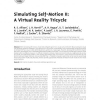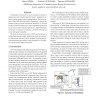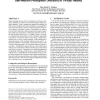12 search results - page 1 / 3 » Simulating Self-Motion II: A Virtual Reality Tricycle |
VR
2002
IEEE
13 years 4 months ago
2002
IEEE
: When simulating self-motion, virtual reality designers ignore non-visual cues at their peril. But providing non-visual cues presents significant challenges. One approach is to ac...
VR
2002
IEEE
13 years 4 months ago
2002
IEEE
When people move there are many visual and non-visual cues that can inform them about their movement. Simulating self motion in a virtual-reality environment thus needs to take th...
VR
2000
IEEE
13 years 9 months ago
2000
IEEE
In the paper, we describe a series of stages in the development of a new virtual locomotion device designed to enhance remote, interpersonal communications. The latest system, cal...
VRST
2006
ACM
13 years 10 months ago
2006
ACM
Despite amazing advances in the visual quality of virtual environments, affordable-yet-effective self-motion simulation still poses a major challenge. Using a standard psychophysi...
CA
1999
IEEE
13 years 9 months ago
1999
IEEE
The recent addition of force and touch feedback to Virtual Reality simulations has enhanced their realism. Research on haptics interfaces is now extended to physical modeling of c...



